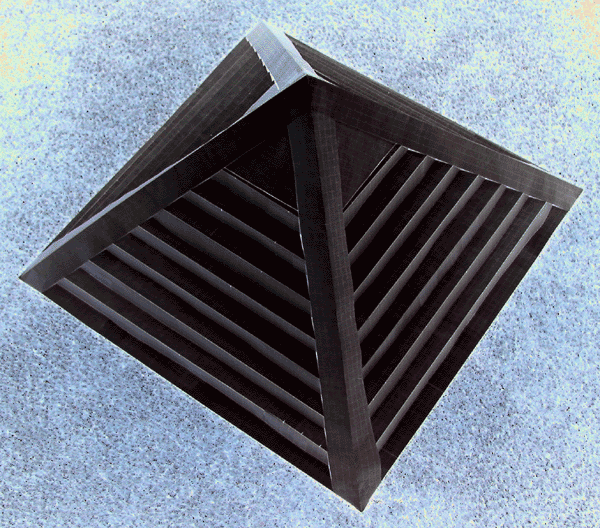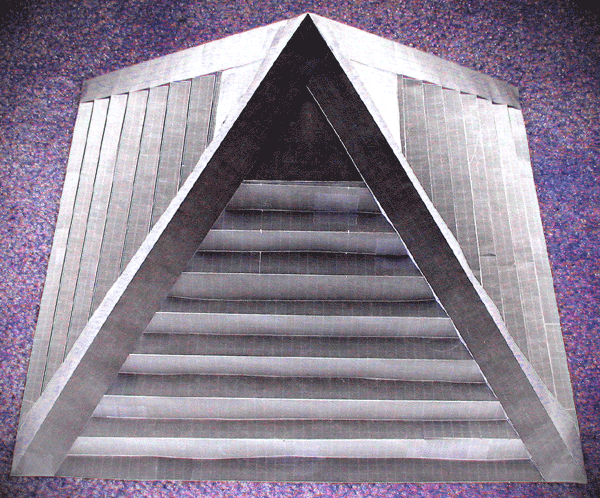
Architectural Designs by Nonjohn
An
Architecturally-Relevant Quotation by Jesus Christ, taken from St. Matthew Chapter 7, Verses 24-27:
24 "Therefore whosoever heareth these sayings of mine, and doeth them, I will liken him unto a wise man, which built
his house upon a rock: 25 And the rain descended, and the floods came, and the winds blew, and beat
upon that house; and it fell not: for it was founded upon a rock. 26
And every one that heareth these sayings of mine, and doeth them not, shall be likened unto a
foolish man, which built his house upon the sand: 27 And the rain descended, and the floods
came, and the winds blew, and beat upon that house; and it fell: and great was the fall of it."
The Nonjohn Pyramid Prototype:

Pyramid Design by Nonjohn (A.K.A. John Tennison) Copyright 1997. All Rights Reserved.

Pyramid Design by Nonjohn (A.K.A. John Tennison) Copyright 1997. All Rights Reserved.
If you would like to have a Nonjohn pyramid custom-built on your property, contact Nonjohn (A.K.A. John Tennison) at info@nonjohn.com.
Commentary
Nonjohn has long admired pyramidal architecture. Pyramids are universal architectural motifs that occur throughout the world.
Nonjohn notes, "Of all the simple geometrical shapes available to the architect, no shape evokes deeper emotions in me than the pyramid. I regard it as the most 'archetypal' of the simple architectural structures. Other simple shapes, such as domes, spheres, and cubes don't have the same emotional effect on me as pyramids. Although I don't have any specific beliefs about pyramids, 'pyramid power,' or any related topics, I am fully aware of the sense of awe inspired by the fact that pyramids have come to be associated with the mysterious and the unknown. Pyramids simultaneously remind us of our desire for immortality, and of the uncertainty of attaining that immortality."
"As a pyramid designer, I have tried to eclectically incorporate what I consider to be the best features of pyramids from many cultures. Pictured above are architectural models of my prototypical pyramid design. They incorporate the smooth edges of Egyptian/African pyramids with the practical stepped-side design of Mexican/Central-American pyramids."
"The smooth edges (inspired by Egyptian/African pyramids) allow the contour of the pyramid to contribute to a more unified and classical structure when viewed at a distance."
"The 'stepped-side' design (inspired by Mexican/Central-American pyramids) allows for the pyramid to contain an internal, livable space with 90-degree angles and vertical walls. These two features are ergonomically important because, as human beings, we stand perpendicular to the ground. Moreover, most of our furniture, shelves, etc. as well as the objects we store in them (such as books) incorporate 90-degree angles. Thus, an internal space which uses 90-degree angles will allow for more efficient storage. If you ever go to the Luxor in Las Vegas, you will readily experience the impracticality of sloped windows as you walk toward them. For example, you will notice that your head bumps into the window before your feet do. Moreover, the angle of sloped windows makes them difficult to look out of towards the ground."
"The internal living space of Nonjohn Pyramids can be outfitted with ultra-modern features/aesthetics, or can be given a more retro theme, such as Egyptian, Mexican, or any other style."
"Lastly, for those of you who live in earthquake country, the pyramid is an extremely stable structural form."
-- Nonjohn (A.K.A. John Tennison)